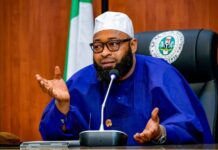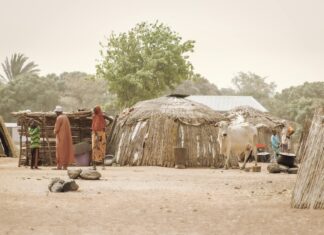By Chris Paul Otaigbe
Against the backdrop of the discomforting issue of the unceasing traffic gridlock that have virtually become the hallmark of Lagos State, the then government of Alhaji Lateef Jakande, in the second Republic, came up with the idea of an Urban rapid rail transit system that would serve the over 17-million strong population of Nigeria’s economic capital.
So, he conceived and proposed a Metro Line Project, in 1983, a year intosecond term of his administration under the President Shehu Shagari civilian administration. He had succeeded in enriching Lagos with massive infrastructure development in his first term and he had hoped he would complete the project in three years, hopefully before the end of his second term as Governor of the State.
Estimated to cost N683 million, the “Metro line Project” was to be handled by Interinfra, a French company. The first phase of the Project was expected to be completed in three years and when it commenced, it was at a relatively slow pace.
Unfortunately, a year before the completion date, the Metro line Project was terminated by the Major General Muhammadu Buhari-led Federal Military Government. Although, the reason given for the cancellation of the project was unavailability of funds.
Twenty years later, in December 2003, due to the enormous deficit in mass transit infrastructure, the then Governor of Lagos State, Senator Bola Ahmed Tinubu, announced the plan to revive the Metro line project.
The project was renamed the “Lagos Light Rail” Project, also known as the “Eko Rail” and it was to be managed by the Lagos Metropolitan Area Transport Authority (LAMATA), founded a year earlier.
Effort to develop the Project involved an initial phase of building 2 lines – the Red and Blue lines, with the intention of extending it to 7 lines.
Although there was a five-year delay before the project kicked off, the contract for the project was awarded to the Chinese firm, Civil Engineering Construction Company (CECC), at a value of $1.2billion.
It had been earmarked to be completed eight years later, in 2011.
After the project commenced, the Lagos State government began shopping for investors that would operate and maintain these lines after construction. The plan was to award a concession contract to the potential investors with a tenure of 25 – 30 years.
The concessionaire would also be involved in the design and construction of the infrastructure relating to the operation and maintenance of the lines.
The Lagos state government obtained a loan of $200 million from the World Bank for the completion of the Light Rail Project and other infrastructure projects.
The Blue line of the “Light Rail” was expected to begin at Marina on Lagos Island and extend to Okokomaiko and anticipated to be entirely funded by the Lagos State Government.
The total length of the Blue line (Okokomaiko to Marina) is 27km (17 miles), comprising a total of 13 stations namely Marina, Ebute Ero, Iddo, Iganmu, Alaba, Mile 2, Festac, Alakija, Trade Fair station, Volkswagen station, LASU and the Okokomaiko station, while the total length of the Red line is expected to extend from Agbado to Marina via Iddo and Murtala Mohammed International Airport). It will span 31km (20 Miles), while a journey along the line was approximated for 35 minutes, the Blue line is expected be constructed at the cost of about N70 billion, sharing three stations with the Red line.
The Red line, on the other hand, runs precisely from Marina to Agbado. Interestingly, the line will share the right-of-way of the Lagos–Kano Standard Gauge Railway.
The Red line extension (to local and international wings of the Airport) – 6km, Green (Marina to proposed Lekki Airport) – 26km, Yellow (Otta to Iddo) – 34km, Purple (Redemption Camp to Ojo) – 60km, Orange (Redemption Camp to Marina) – 42km and Brown (Mile 12 to Marina) – 20km.
Upon completion, the Blue and Red lines are expected to carry 1.6 million passengers daily.
The construction of the other five lines were to commence after the blue and red lines have been completed. The other five lines were expected to extend to places like the local and international wings of the Muritala Muhammad Airport, Ikeja; the proposed Lekki Airport; Otta; the Redemption Camp and Mile 12.
The trains to be initially used for the Lagos Light Rail project were to be acquired from Canada by the Raji Fashola-led administration. These were the controversial “fairly-used” H5 series subway trains formerly used by the Toronto Transport Commission (TTC).
That is the profile of the Project as envisioned by the founders of the Metro Line Mass Transit alternative transportation mode designed to ease chaotic Lagos Traffic and facilitate smoother and more comfortable movement for its Residents.
However, recently, controversies began generating around the project, whose completion has experienced much delays. A Public accountability NGO, known as BudgIT called out the Lagos State government to come clean with the real records of the transaction surrounding the Light Rail Project. It had charged the State government to clarify the controversy that had been trailing the light rail budget in recent time.
The trending report by China Railway Construction Corporation, the company in charge of the project had ticked off the curiosity of many observers of the Project.
Their concern was all about the discrepancy between the figure contained in the 2010 report delivered by China Railway Construction Corporation to its shareholders (USD$182m), which was published on the company’s website, and the officially acclaimed figure by the Lagos State government, which puts the project cost at USD$1.2bn.
According to the NGO, the value of the Group’s new overseas contracts during the reporting period was RMB9.5568 billion, which involved the following significant overseas projects: light rail project in Lagos, Nigeria (the value of the contracts for blue line and red line was RMB1.256 billion).
The NGO noted that the penchant for shrouding details of the budget in secrecy is what has led to the suspicion arising from the humongous difference between the figure published on the Contractor’s website and that which the Lagos State government put out to the Public as the actual amount budgeted for the Project.
While being conscious of possible underlying factors that could be responsible for this humongous difference, BudgIT said “we say with certitude that ambiguities of this like would have ceased to occur had the state government yielded to our demand and that of the people to put an end to its budget secrecy. Lagosians deserve to know, steadily and accordingly, full details of how state resources are being used without any hesitation on the part of the government.
“Aside from the monorail, we reiterate our concern about the same opacity that plaques toll gates operation and large constructions in Lagos. Same goes to the abject lack of transparency in the procurement process, an impenetrable system which has ring-fenced public funds around private interests.
To put to rest all doubts and concerns, BudgIT demands that the Lagos state government should break the silence and come out clean on this matter. What is the overall cost of the Monorail project? Why the discrepancy between the official figure and the contractor’s report? These are key questions that demand an immediate response from the state authority.” The Report stated.
In a written recent response he issued to the media, Kola Ojelabi, an assistant director of corporate communication in Lagos Metropolitan Area Transport Authority (LAMATA) meant to set the records straight, said the claims by those who believe the conflicting figures indicated some corruption in the Project by the State government may have gotten it all mixed up.
He stated that the report which alluded to the fact that the contract of RMB1.256 billion ($182 million) was for both blue and red-light rail projects, was not correct. According to him, the Lagos state government had awarded three contracts for the survey and design of the Blue and Red Rail lines for implementation respectively in 2009 and Blue Line phase 2A for the construction of earthwork, ballast, sleepers and tracks for one kilometer and Iganmu Station between Iganmu to Mile 2 at the cost of $182 million.
He went further to state that the state government had intended to implement the red line as the first rail line but due to the unavailability of the corridor as a result of the constraints contained in the railway Act for using the corridor, it decided to concentrate efforts on the blue line. The survey and design for the red line was therefore stepped down.
According to him, the project’s global cost of about $1.17 billion as contained in the Lagos state government document on the rail project is the verified project cost of the blue line rail project as at the time it was approved in 2009.
It includes construction of the civil works particularly fixed infrastructure; rolling stocks, signaling and telecommunication, operational control center (OCC), fare collection system, maintenance depot and equipment, power generation and supply, fencing and security of entire alignment which are currently on-going. The government has continued to implement the rail project within the global contract cost.
“For the avoidance of doubt, the Lagos state government has successfully completed the survey, mobilization and detailed design of the 27-kilometre blue line rail project, completed all civil infrastructure works from Mile 2 to National Theatre which includes the construction of rail bridge, stabling yard, Pway track and completed four railway stations namely Mile2, Alaba, Iganmu and National Theatre and is currently constructing the bridge crossing the lagoon from National Theatre to Marina.” He stated.
Concerning the comparison of the blue rail line with the Addis Ababa light rail project, Ojelabi maintained that rail construction worldwide is not compared on the basis of like-for-like because of difference in terrain (swamp, lagoon, removal of ship wreckages), design of project (elevated sections and stations), infrastructure, technology (UIC60 tracks manufactured to European standard), compensation as construction passes through already built up environment, third party issues and taxation among others.
The project, he said, is an urban rail project that, by the nature and structure involves lots of issues ranging from acquisition, payment of compensation and resettlement of project affected persons would have to be taken care of to ensure a smooth sail.
For instance, about a third of the 27-kilometre blue line rail project is elevated, crossing swampy terrain and the Lagos lagoon where a lot relocation, reconstruction and resettlements were involved. Construction within the swampy terrain and the lagoon entails that some piers foundation would go down between 40 and 88 meters.
On the claim that a loan for the construction of the project was guaranteed by the World Bank, the LAMATA Assistant Director stated the state government never received any loan to support the construction of the blue line rail project.
The Blue Line Rail project is the flagship transport project of the Lagos state government. Blue Line project is a 27-kilometre rail route designed to run from Okokomaiko eastwards to Mile 2, and then proceeds to Marina via Ijora.
A major part of the rail alignment runs in the middle of the ongoing Lagos Badagry Expressway (LBE) road expansion development from Okokomaiko to Iganmu before ascending on an elevated railway bridge to the National Theatre, and proceeds via Ijora to Marina. Construction of the Theatre to Marina is a 5.5 km elevated rail section consisting of a terminal station at Marina, bridge works and track works.
The Blue Line Rail project was awarded through an international competitive bidding and won by China Civil Engineering Construction Company (CCECC), subsidiary of China Railway Construction Corporation (CRCC).
The project has over the year rekindled hope of better transport experience when it finally commenced operations.
On the face of it, when one looks at the amount of work to be done, the terrains to be crossed, coupled with the multifarious compensation components, the complexities and human complications that would be involved in a project of this magnitude, the frightening differential, between the figures claimed by critics and the one the State government insists is the accurate amount budgeted for the Project, may somewhat pale to insignificance. In other words, with all that is needed to be done for the Project, it is almost obvious that the $182 million claimed by those who lifted it from the website of the Chinese Contractor may actually have been the amount meant for the Front End Engineering and Design (FEED) as affirmed by the LAMATA spokesman. While the $1.2 billion seems more believable when one imagines what it would take to ‘wire’ virtually the whole of the State, end to end.
However, the State government owes Lagosians the obligation to carry them along in the execution of this laudable project at every stage of its implementation. They need to let the people know, not just how, where and when the infrastructure would be mounted as a public alert or notice for pedestrians or motorists to note to guide movements during engineering work, but to brief Lagosians how much exactly is being expended at every point of the Project. This is the accountability being demanded by the BudgIT and many concerned quarters who are interested in seeing the Metro Line or Blue Line Light Rail project come through for the people of Lagos.
As it stands today, Lagosians are tired of the monstrous traffic gridlock killing the residents of the emerging mega city.
With the determination of the Babajide Sanwo-Olu administration to tackle traffic congestion and improve transportation, as Ojelabi enthusiastically enlightens, the people of Lagos actually hope the rail project would breathe the fresh breath of air that would eventually bring the project to passenger operation in the life of this administration… so that the average Lagosian can travel in comfort, at affordable fare and reduced travel time.
In Brief…
Towards the end of the week, the Lagos State Governor, Babajide Sanwo-Olu appointed Engr. Abimbola Akinajo as the new Managing Director of Lagos Metropolitan Area Transport Authority (LAMATA).
She is the first female and third Managing Director of the 16-year old transport planning, implementing, regulating and franchising authority. She succeeds Engr. Abiodun Dabiri.
A chartered civil engineer with over 30 years post qualification experience, the last 25 of which has been in the design and delivery of major transport infrastructure projects, Engr. Akinajo earned a B.Sc. in Civil Engineering from the University of Lagos.
The immediate Managing Director of Nexant Consulting Limited, a multi-disciplinary construction management, engineering consulting firm, Engr. Akinajo, comes to LAMATA with a wealth of experience in civil and rail infrastructure delivery.
The consulting firm has extensive expertise and experience in Railway Engineering works (tracks, signaling, telecoms, power & electrification), Major Civil Engineering projects (stations, depots, highways, bridges, buildings, etc.), Structural Engineering Works, as well as Asset Management.
The consulting firm was at a time the consultant for the Blue Line Rail project.
Would it be too early to say, the Governor has placed the round peg in the right hole…
Hopefully, she would bring her treasured expertise and experience to bear on the project so that the deliverables the founding fathers had dreamed up for the people-oriented, economy-boosting project, can be delivered on time and in good, sustainable quality.
Felabration 2019: Teacher Don’t Teach me Nonsense
That was the theme of the symposium held on the opening day of the weeklong program lined up for this year’s edition of the Felabration Festival which took place from October 14-20, 2019.
Held on the opening day of the program, the symposium had as part of its Panel of Discussants Prof Akin Oyebode and some other African activists.
A professor of international law and jurisprudence, Oyebode and the others spoke at the 2019 Felabration Debate, with the theme, ‘’Teacher Don’t Teach me Nonesense’’, at the NECA House, Alausa, Ikeja.
Conceived by his eldest child, Yeni, in 1998, Felabration is a festival of music and arts commemorating the life and times of Fela
Anikulakpo Kuti.
Felabration has been a yearly event, with the exception of 1999, in honor of the late musical icon who was born on Oct. 15, 1938 and died on Aug. 2, 1997.
The speakers at the Felabration Debate said that going by its theme, Fela, through his music, was able to educate and entertain a good number of people.
Oyebode described the late Afro-beat music legend as an iconoclast and a musical genius who was able to effect societal change through his music.
According to him, Fela used his music to give confidence to Nigerians and
contributed to national development.
” Fela was the greatest African musician who demonstrated how African values had been eroded by putting firewood on his newly purchased Mercedes Benz.
” His music never dies due to the strong messages they convey; his music remains indelible, his heritage has survived more than 20 years and will go forever,” he said.
Kingslee Daley, a British journalist and activist, also known as ‘Akala’, also called on people to always seek for knowledge and not take whatever “nonsense they were taught.”
Akala said that the internet and social media had made it easier for people to research whatever information they wanted.
” Musicians should be careful how they handle Fela’s messages, as some artistes are seen to be using Fela’s music at the expense of his message.
” You will see music videos with the
Afrobeat showing flashy cars and clothes, which is contradictory to Fela’s messages; they are teaching nonsense.” She said.
Sefi Atta, a Nigerian playwright, said Fela’s performance was outstanding when compared with other musicians who only tagged themselves as activists.
She said Afro-beat has been her guiding principles and ideas, adding that there is so much to learn from Fela’s songs. “So, I am not surprised some other artistes identify with him.”
Robert Kyagulanyi, is a Ugandan musician and activist. He said the late afro-beat maestro was a man who lived before his time but was silenced before the
emergence of social media.
He said that Fela had explored music as the most powerful means of communication and as an agent of promoting social change in communities.
Kyagulanyi enjoined African musicians to adequately use their music as tool for effecting change in the society like Fela and Bob Marley did.
” Fela influenced me so much, likewise most of Nigerian authors like late Chinua Achebe and more; this is because they have been able to contribute to societal growth.
” I want African musicians to imbibe Fela’s style of educating and entertaining the populace through his music; musicians have overwhelming power to change the society, they should be conscious of this,” he said.
Felabration is held on the week of Fela’s birthday. The event features musical performances from top music acts from Nigeria and guest appearances from internationally acclaimed musicians and personalities. It also consists of street parades, symposia on social and topical issues, debates and photo exhibitions.
From the opening day till the last day of the event, the 2019 edition of Felabration was filled with activities that lived up to its billing as truly representative of the essence and quality of artistry and discourse Fela brought onto the national conversation and the impact he had on the life of the country and the people in particular.










